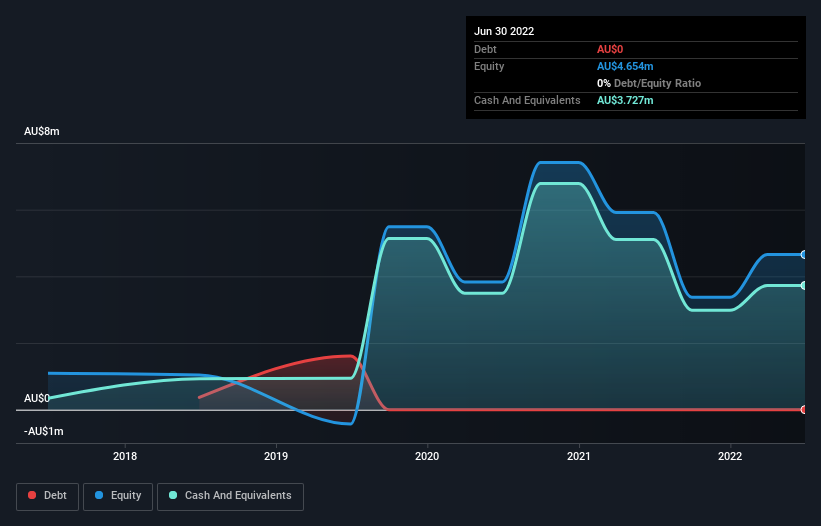
Just because a business does not make any money, does not mean that the stock will go down. For example, although software-as-a-service business Salesforce.com lost money for years while it grew recurring revenue, if you held shares since 2005, you'd have done very well indeed. But while history lauds those rare successes, those that fail are often forgotten; who remembers Pets.com?
So, the natural question for K-TIG (ASX:KTG) shareholders is whether they should be concerned by its rate of cash burn. For the purposes of this article, cash burn is the annual rate at which an unprofitable company spends cash to fund its growth; its negative free cash flow. First, we'll determine its cash runway by comparing its cash burn with its cash reserves.
View our latest analysis for K-TIG
When Might K-TIG Run Out Of Money?
You can calculate a company's cash runway by dividing the amount of cash it has by the rate at which it is spending that cash. As at June 2022, K-TIG had cash of AU$3.7m and no debt. Importantly, its cash burn was AU$4.8m over the trailing twelve months. So it had a cash runway of approximately 9 months from June 2022. To be frank, this kind of short runway puts us on edge, as it indicates the company must reduce its cash burn significantly, or else raise cash imminently. The image below shows how its cash balance has been changing over the last few years.

How Well Is K-TIG Growing?
Some investors might find it troubling that K-TIG is actually increasing its cash burn, which is up 21% in the last year. On a more positive note, the operating revenue improved by 137% over the period, offering an indication that the expenditure may well be worthwhile. If that revenue does keep flowing reliably, then the company could see a strong improvement in free cash flow simply by reducing growth expenditure. We think it is growing rather well, upon reflection. In reality, this article only makes a short study of the company's growth data. This graph of historic revenue growth shows how K-TIG is building its business over time.
Can K-TIG Raise More Cash Easily?
While K-TIG seems to be in a fairly good position, it's still worth considering how easily it could raise more cash, even just to fuel faster growth. Companies can raise capital through either debt or equity. Commonly, a business will sell new shares in itself to raise cash and drive growth. By looking at a company's cash burn relative to its market capitalisation, we gain insight on how much shareholders would be diluted if the company needed to raise enough cash to cover another year's cash burn.
K-TIG has a market capitalisation of AU$35m and burnt through AU$4.8m last year, which is 14% of the company's market value. As a result, we'd venture that the company could raise more cash for growth without much trouble, albeit at the cost of some dilution.
So, Should We Worry About K-TIG's Cash Burn?
On this analysis of K-TIG's cash burn, we think its revenue growth was reassuring, while its cash runway has us a bit worried. Even though we don't think it has a problem with its cash burn, the analysis we've done in this article does suggest that shareholders should give some careful thought to the potential cost of raising more money in the future. Taking a deeper dive, we've spotted 6 warning signs for K-TIG you should be aware of, and 2 of them shouldn't be ignored.
Of course K-TIG may not be the best stock to buy. So you may wish to see this free collection of companies boasting high return on equity, or this list of stocks that insiders are buying.
Valuation is complex, but we're here to simplify it.
Discover if K-TIG might be undervalued or overvalued with our detailed analysis, featuring fair value estimates, potential risks, dividends, insider trades, and its financial condition.
Access Free AnalysisHave feedback on this article? Concerned about the content? Get in touch with us directly. Alternatively, email editorial-team (at) simplywallst.com.
This article by Simply Wall St is general in nature. We provide commentary based on historical data and analyst forecasts only using an unbiased methodology and our articles are not intended to be financial advice. It does not constitute a recommendation to buy or sell any stock, and does not take account of your objectives, or your financial situation. We aim to bring you long-term focused analysis driven by fundamental data. Note that our analysis may not factor in the latest price-sensitive company announcements or qualitative material. Simply Wall St has no position in any stocks mentioned.
About ASX:KTG
K-TIG
K-TIG Limited, a technology company, develops and manufactures welding technology in Australia, the United Kingdom, the United States, the Asia Pacific, and internationally.
Medium with adequate balance sheet.
Market Insights
Community Narratives




